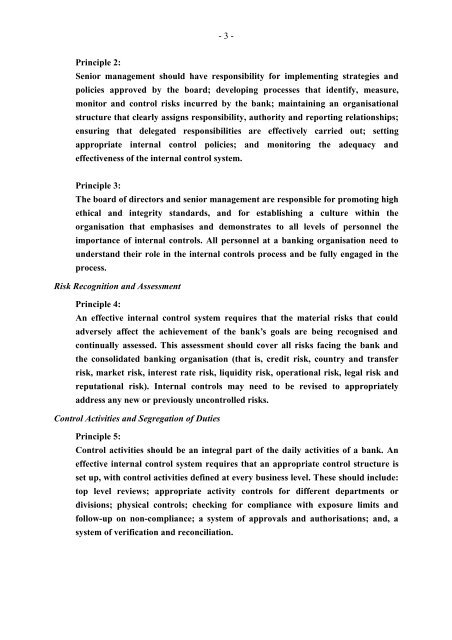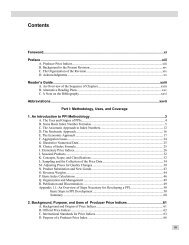Framework for Internal Control Systems in Banking Organisations
Framework for Internal Control Systems in Banking Organisations
Framework for Internal Control Systems in Banking Organisations
You also want an ePaper? Increase the reach of your titles
YUMPU automatically turns print PDFs into web optimized ePapers that Google loves.
- 3 -<br />
Pr<strong>in</strong>ciple 2:<br />
Senior management should have responsibility <strong>for</strong> implement<strong>in</strong>g strategies and<br />
policies approved by the board; develop<strong>in</strong>g processes that identify, measure,<br />
monitor and control risks <strong>in</strong>curred by the bank; ma<strong>in</strong>ta<strong>in</strong><strong>in</strong>g an organisational<br />
structure that clearly assigns responsibility, authority and report<strong>in</strong>g relationships;<br />
ensur<strong>in</strong>g that delegated responsibilities are effectively carried out; sett<strong>in</strong>g<br />
appropriate <strong>in</strong>ternal control policies; and monitor<strong>in</strong>g the adequacy and<br />
effectiveness of the <strong>in</strong>ternal control system.<br />
Pr<strong>in</strong>ciple 3:<br />
The board of directors and senior management are responsible <strong>for</strong> promot<strong>in</strong>g high<br />
ethical and <strong>in</strong>tegrity standards, and <strong>for</strong> establish<strong>in</strong>g a culture with<strong>in</strong> the<br />
organisation that emphasises and demonstrates to all levels of personnel the<br />
importance of <strong>in</strong>ternal controls. All personnel at a bank<strong>in</strong>g organisation need to<br />
understand their role <strong>in</strong> the <strong>in</strong>ternal controls process and be fully engaged <strong>in</strong> the<br />
process.<br />
Risk Recognition and Assessment<br />
Pr<strong>in</strong>ciple 4:<br />
An effective <strong>in</strong>ternal control system requires that the material risks that could<br />
adversely affect the achievement of the bank’s goals are be<strong>in</strong>g recognised and<br />
cont<strong>in</strong>ually assessed. This assessment should cover all risks fac<strong>in</strong>g the bank and<br />
the consolidated bank<strong>in</strong>g organisation (that is, credit risk, country and transfer<br />
risk, market risk, <strong>in</strong>terest rate risk, liquidity risk, operational risk, legal risk and<br />
reputational risk). <strong>Internal</strong> controls may need to be revised to appropriately<br />
address any new or previously uncontrolled risks.<br />
<strong>Control</strong> Activities and Segregation of Duties<br />
Pr<strong>in</strong>ciple 5:<br />
<strong>Control</strong> activities should be an <strong>in</strong>tegral part of the daily activities of a bank. An<br />
effective <strong>in</strong>ternal control system requires that an appropriate control structure is<br />
set up, with control activities def<strong>in</strong>ed at every bus<strong>in</strong>ess level. These should <strong>in</strong>clude:<br />
top level reviews; appropriate activity controls <strong>for</strong> different departments or<br />
divisions; physical controls; check<strong>in</strong>g <strong>for</strong> compliance with exposure limits and<br />
follow-up on non-compliance; a system of approvals and authorisations; and, a<br />
system of verification and reconciliation.
















